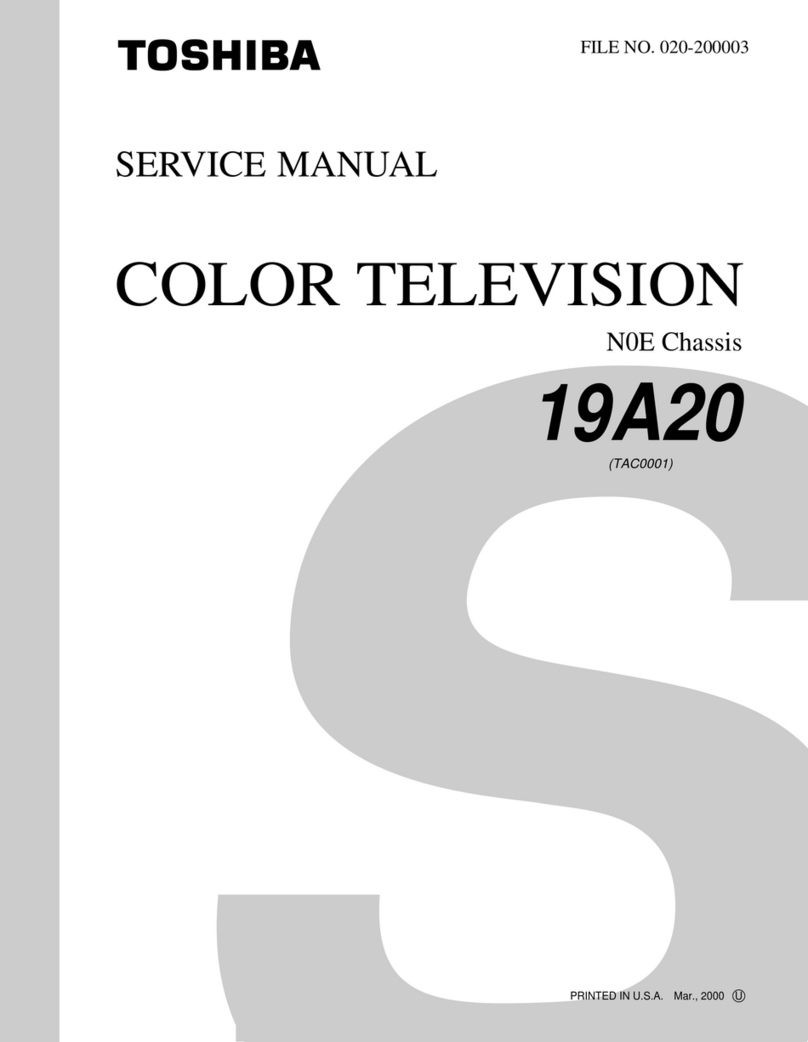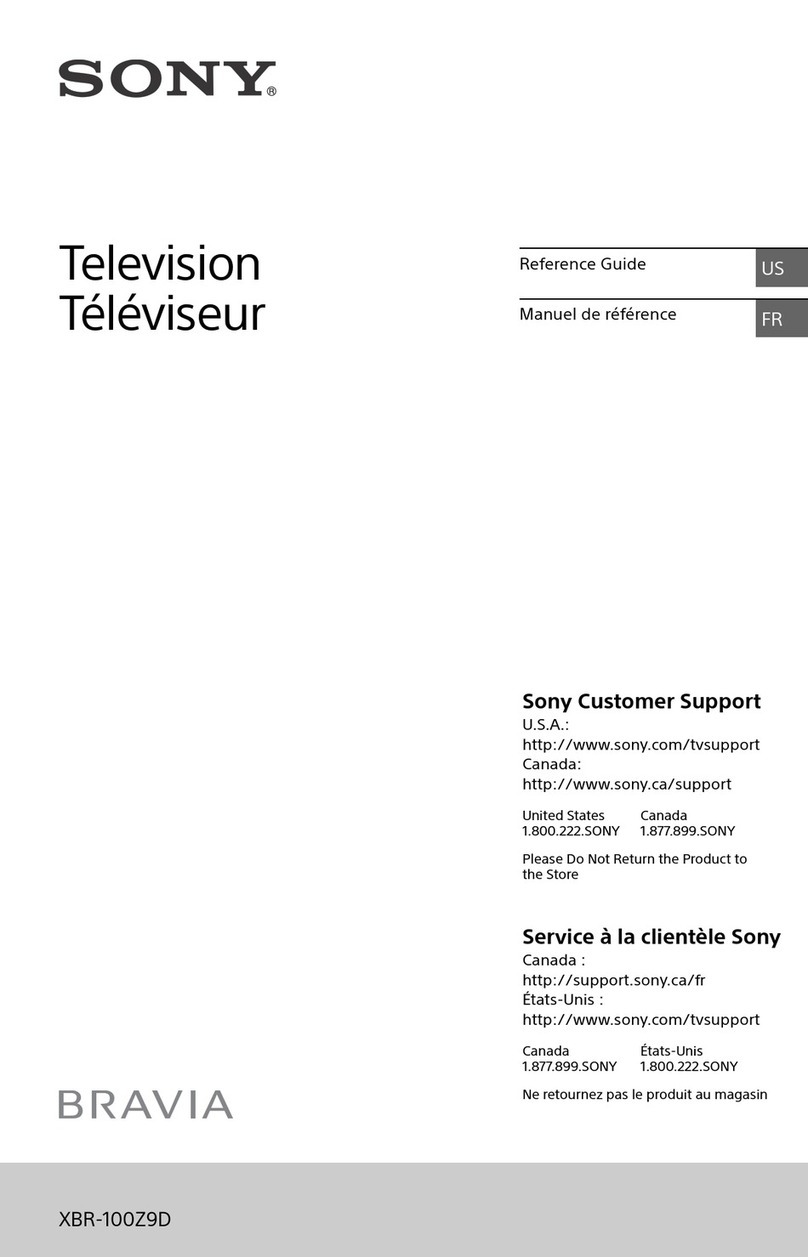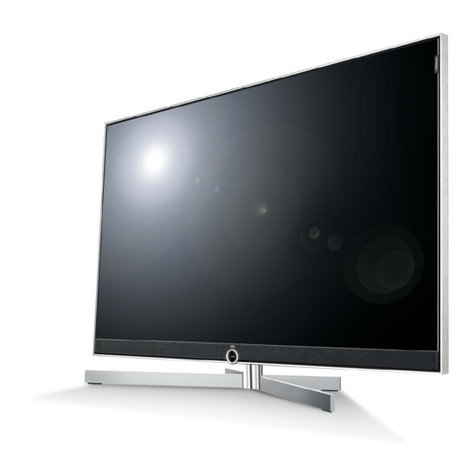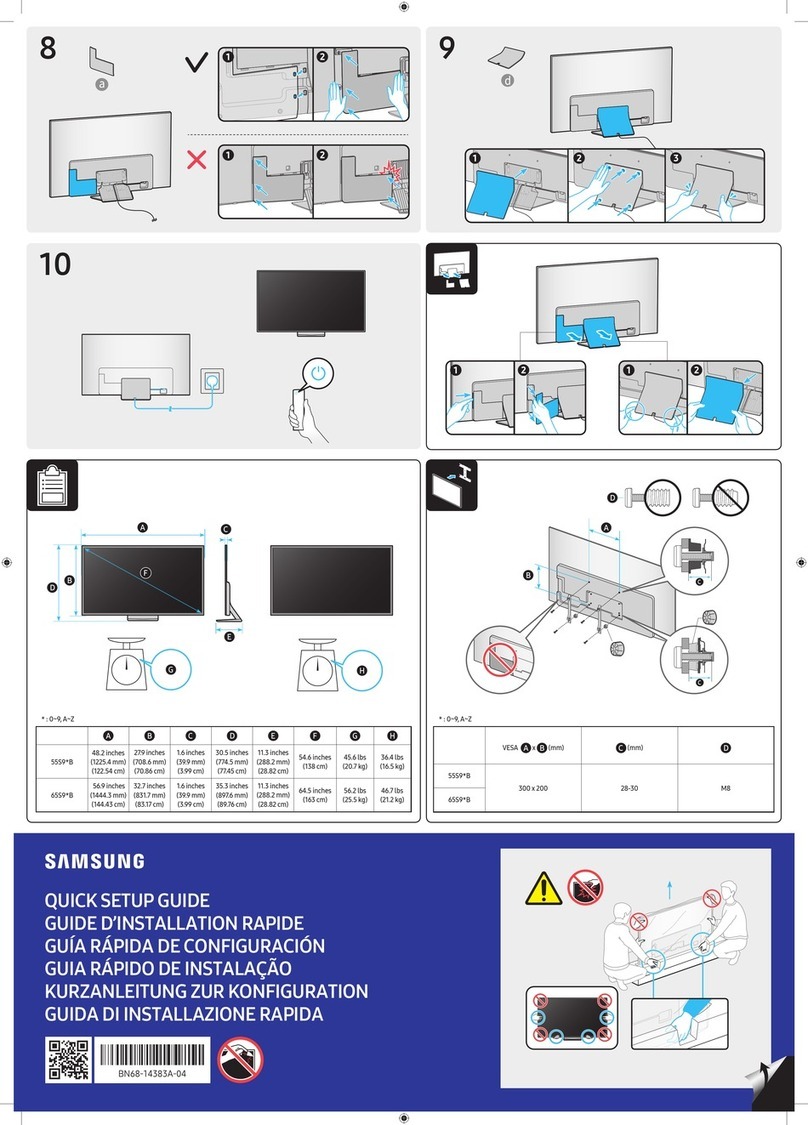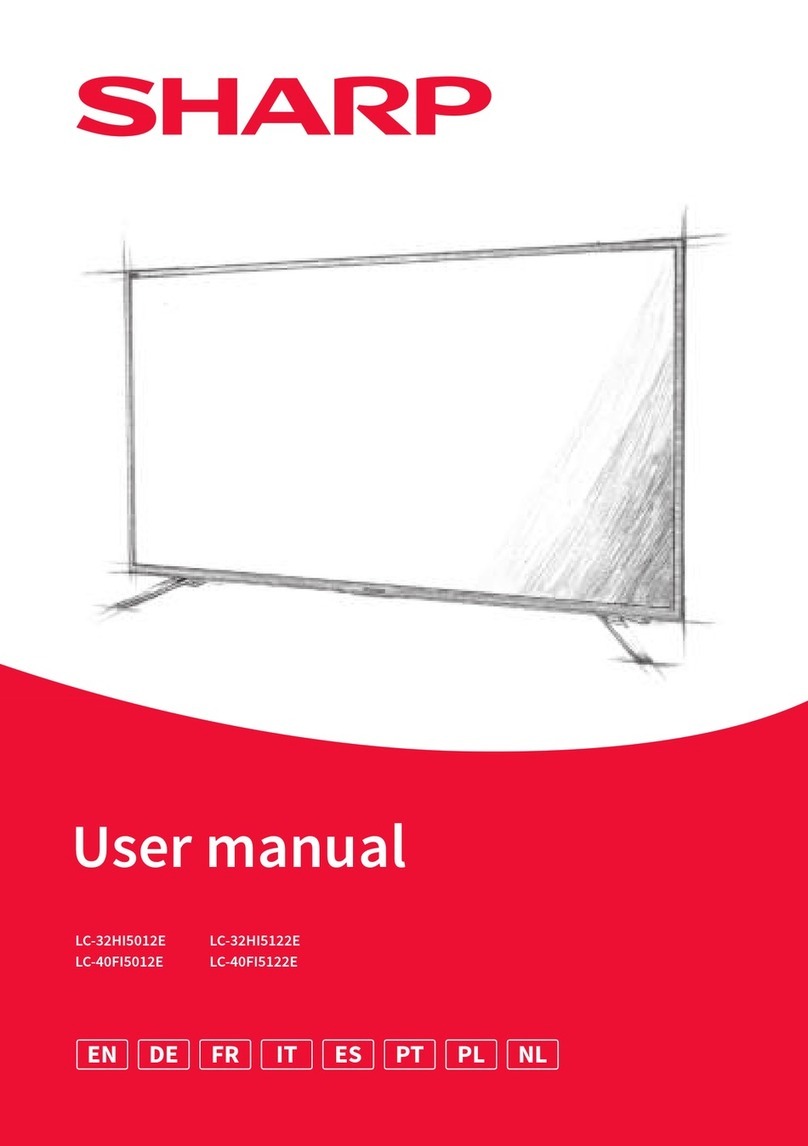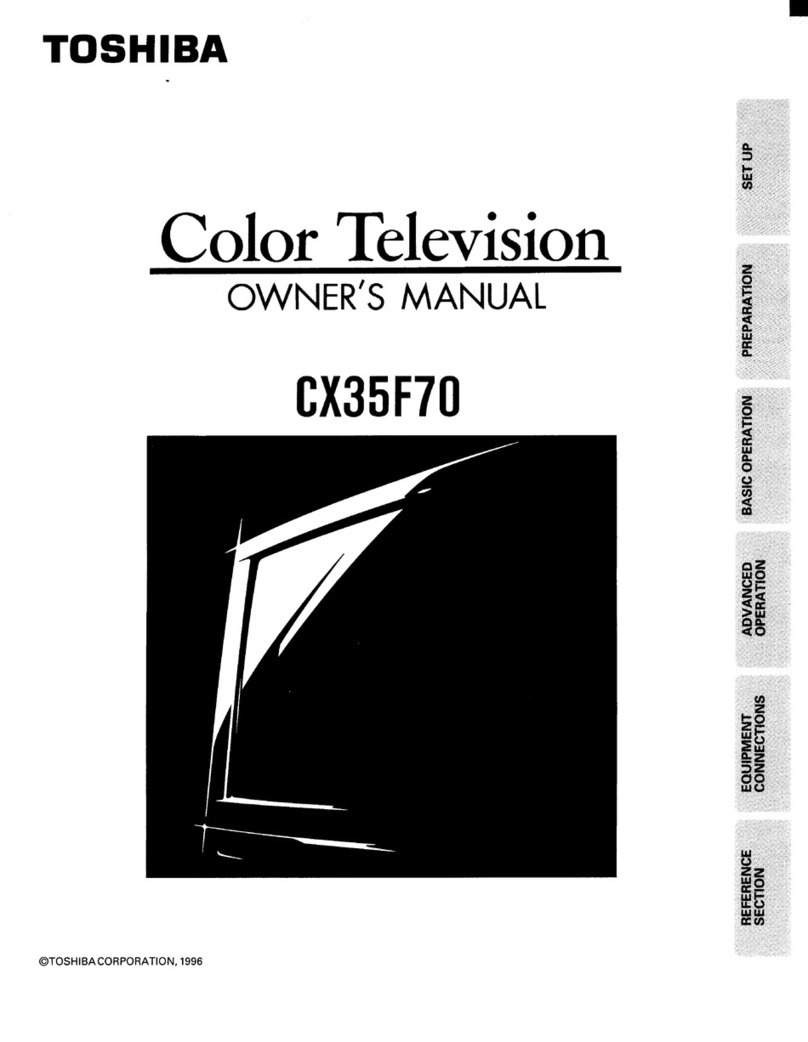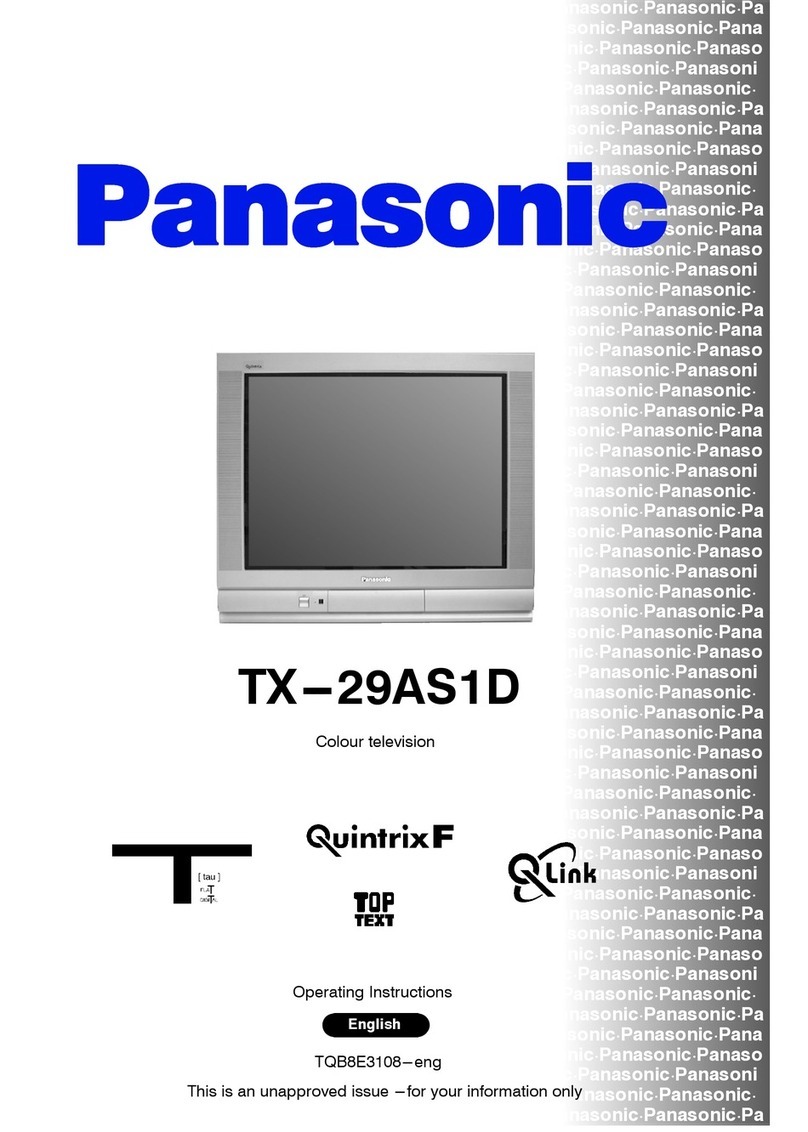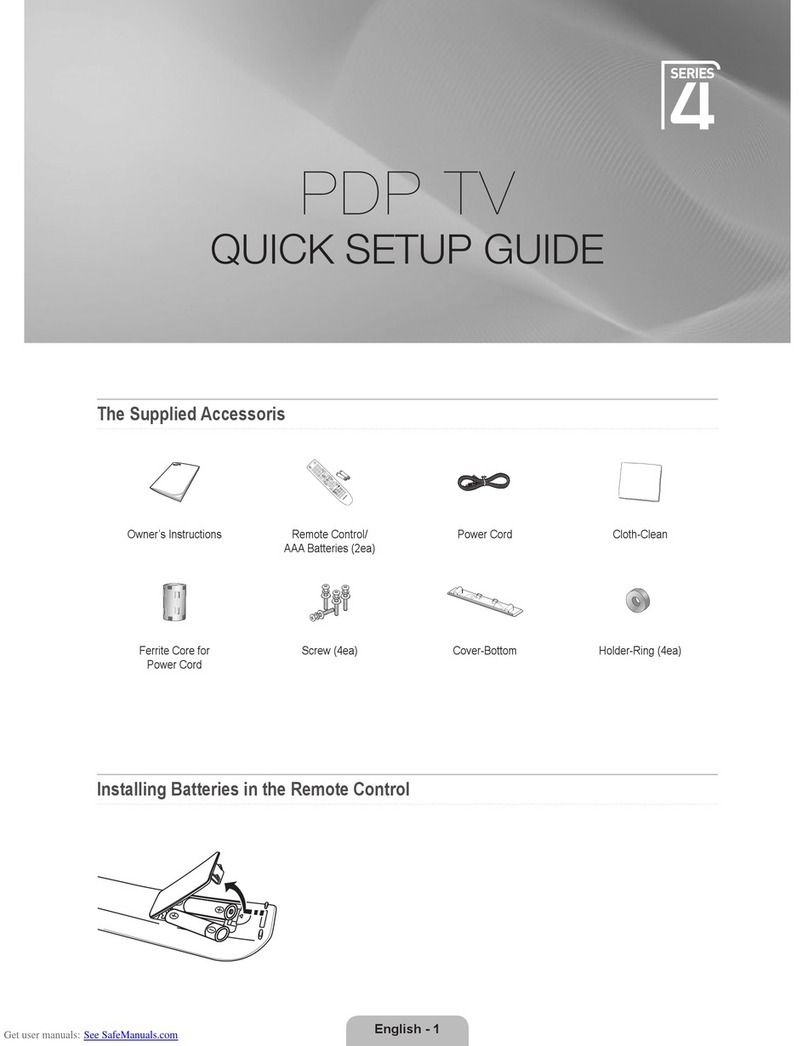SITRONICS 25F83 User manual

FILENO.SM-CTV-098
COLOR TELEVISION
MODEL NO. 25F83/PF25F83/PF29F83
CHASSIS NO. CH-16(S)
Please read this manual carefully before service.
SERVICE MANUAL

SERVICE MANUAL
ADJUSTMENTS
SET-UP ADJUSTMENTS
The following adjustments should be made when a complete realignment is required or a new
picture tube is installed.
Perform the adjustments in the following order:
1. Color purity
2. Convergence
3. White balance
Notes:
①The purity/convergence magnet assembly and rubber wedges need mechanical
positioning. Refer to Fig1, 2.
②For some picture tubes, purity/ convergence adjustments are not required.
1. Color Purity Adjustment
Preparation:
Before starting this adjustment, adjust the vertical sync, horizontal sync, vertical amplitude and
focus.
1.1 Face the TV set north or south.
1.2 Connect the power plug into the wall outlet and turn on the main power switch of the TV set.
1.3 Operate the TV for at least 15 minutes.
1.4 Degauss the TV set using a specific degaussing coil.
1.5 Set the brightness and contrast to maximum.
1.6 Counter clockwise rotate the R /B low brightness potentiometers to the end and rotate the
green low brightness potentiometer to center.
1.7 Receive green raster pattern signals.
1.8 Loosen the clamp screw holding the deflection yoke assembly and slide it forward or backward
to display a vertical green zone on the screen. Rotate and spread the tabs of the purity magnet
around the neck of the CRT until the green zone is located vertically at the center of the screen.
1.9 Slowly move the deflection yoke assembly forward or backward until a uniform green screen is
obtained.
1.10Tighten the clamp screw of the assembly temporarily. Check purity of the red raster and blue
raster until purities of the three rasters meet the requirement.
2. Convergence Adjustment
Preparation:
Before attempting any convergence adjustment, the TV should be operated for at least 15
minutes.
2.1 Center convergence adjustment
2.1.1 Receive dot pattern.
2.1.2 Adjust the brightness/contrast controls to obtain a sharp picture.
5

SERVICE MANUAL
2.1.3 Adjust two tabs of the 4-pole magnet to change the angle between them and red and blue
vertical lines are superimposed each other on the center of the screen.
Yok
Fig. 1
2.1.4 Turn both tabs at the same time keeping the angle constant to superimpose red and blue
horizontal on the center of the screen.
2.1.5 Adjust two tabs of the 6-pole magnet to superimpose red/blue line and green line.
2.1.6 Remember red and blue movement. Repeat steps 2.1.3~2.1.5 until optimal convergence is
obtained.
2.2 Circumference convergence adjustment
2.2.1 Loosen the clamp screw holding the deflection yoke assembly and allow it tilting.
2.2.2 Temporarily put the first wedge between the picture tube and deflection yoke assembly.
Move front of the deflection yoke up or down to obtain better convergence in circumference.
Push the mounted wedge in to fix the yoke temporarily.
2.2.3 Put the second wedge into bottom.
2.2.4 Move front of the deflection yoke to the left or right to obtain better convergence in
circumference.
2.2.5 Fix the deflection yoke position and put the third wedge in either upper space. Fasten the
deflection yoke assembly on the picture tube.
2.2.6 Detach the temporarily mounted wedge and put it in either upper space. Fasten the
deflection yoke assembly on the picture tube.
2.2.7 After fastening the three wedges, recheck overall convergence and ensure to get optimal
convergence. Tighten the lamp screw holding the deflection yoke assembly.
3. White Balance Adjustment
Generally, white balance adjustment is made with professional equipment. It’s not practical to
get good white balance only through manual adjustment. For TVs with I2C bus control, change
6

SERVICE MANUAL
Center Convergence by Convergence Magnets
Incline the Yoke Up (or Down) Incline the Yoke Right (or Left)
the bus data to adjust white balance.
Fig. 2
4-pole Magnet Movement 6-pole Magnet Movement
Circumference Convergence by DEF Yoke
Fig.3
7

SERVICE MANUAL
CIRCUIT ADJUSTMENTS
Preparation:
Circuit adjustments should be made only after completion of set-up adjustments.
Circuit adjustments can be performed using the adjustable components inside the TV set. For TVs
with I2C bus control, first change the bus data.
1. Degaussing
A degaussing coil is built inside the TV set. Each time the TV is powered on, the degaussing
coil will automatically degauss the TV. If the TV is magnetized by external strong magnetic field,
causing color spot on the screen, use a specific degausser to demagnetize the TV in the
following ways. Otherwise, color distortion will be shown on the screen.
1.1 Power on the TV set and operate it for at least 15 minutes.
1.2 Receive red full-field pattern.
1.3 Power on the specific degausser and face it to the TV screen.
1.4 Turn on the degausser. Slowly move it around the screen and slowly take it away from the TV.
1.5 Repeat the above steps until the TV is degaussed completely.
2. Confirmation and Adjustment for Voltage
Caution: +B voltage has close relation to high voltage. To prevent X-ray radiation, set +B
voltage to the rated value.
2.1 Power on the TV and receive Philips test pattern.
2.2 Check the resistors and coils for being burned. (If the fuse is burned out, do not power on the
TV again until the cause is found out.)
2.3 Measure voltages of test points with the digital voltmeter. Measure the CRT high voltage with
the high-voltage testing equipment and heater voltage with the high-frequency effective
voltmeter. The rated values are shown as table 2.
Table 2
Test Point Voltage (V)
Negative of VD831 145±1.5V
Negative of VD461B 12±1V
Negative of VD832 15±1V
Positive of C462 17±1V
Positive of C452 47±3V
Positive of C492 195±5V
Heater 6.3±0.3Vrms
CRT anode voltages 25KV±1KV (for 25" pure flat CRT only)
29KV±1KV (for 25" super pure flat CRT only)
28.8KV±1KV (for 29” CRT only)
8

SERVICE MANUAL
3. High Voltage Inspection
Caution: No high voltage adjustment components inside the chassis. Please perform
high voltage inspection in the following ways.
3.1 Connect a precise static high voltmeter to the second anode (inside the high voltage cap) of the
CRT.
3.2 Plug in the supply socket (150-250V ~, 50Hz) and turn on the TV. Set the brightness and
contrast to minimum (0μA).
3.3 The high voltage reading should be less than the limited EHT voltage.
3.4 Change the brightness from minimum to maximum, and ensure high voltage not beyond the
limitation in any case.
Nominal EHT voltage Limited EHT voltage Remarks
25KV±1KV 30KV for25"pureflatCRTonly
29KV±1KV 32KV for 25" super pure flat CRT only
28.8KV±1KV 32KV for29”CRTonly
Note: The data sheet may differ dependent on different CRTs.
4. Focus Adjustment
Caution: Dangerously high voltages are present inside the TV. Extreme caution should
be exercised when working on the TV with the back removed.
4.1 After removing the back cover, look for the FBT on the main PCB. There should be a FCB on
the FBT.
4.2 Power on the TV and preheat it for 15 min.
4.3 Receive a normal TV signal. Rotate knob of the FCB until you get a sharp picture.
BeforeAdjusting AfterAdjusting
Fig. 4
5. Safety Inspection
5.1 Inspection for insulation and voltage-resistant
Perform safety test for all naked metal of the TV. Supply high voltage of 3000V, 50Hz (limit
current of 10mA) between all naked metal and cold ground. Test every point for 3 sec. and
ensure no arcing and sparking.
5.2 Requirements for insulation resistance
Measure resistance between naked metal of the TV and feed end of the power cord to be
infinity with a DC-500 high resistance meter and insulation resistance between the naked metal
and degaussing coil to be over 20MΩ.
9

SERVICE MANUAL
6. SERVICE mode
6.1 To enter the SERVICE mode
Set the volume to 0 by the remote control. Then press and hold the MUTE button on the
remote control and MENU button on the TV at the same time for over 2 seconds. In the S mode,
press the POWER button to quit the S mode.
S
(“S”is red and other items are yellow.)
Use the ↓/↑buttons on the remote control to highlight an adjustment and the ←/→buttons
to adjust it.
The POS+/-,↑/↓/←/→,1~6, RECALL, VOL+/-, MUTE and POWER buttons on the remote
control function in the S mode, but 100+, 7, 8, 9 and 0 buttons not.
6.2 Bus data Table 3 Bus data
Data in S
Mode Adjustment Description
OP1 7B Option set byte 1(See Table 4)
OP2 4C Option set byte 2(See Table 4)
OP3 FF Option set byte 3(See Table 4)
OP4 F5 Option set byte 4(See Table 4)
OP5 36 Option set byte 5(See Table 4)
OP6 28 Option set byte 6(See Table 4)
AVG Vertical output
INIT Initializing E2PROM
TAB Data check sheet(See Table 5)
VX00 19 4:3
VX50 01 16:9
VX99 38 Zoom
VS Set to the optimum Half vertical output
VA Set to the optimum Vertical amplitude (When vertical frequency is identified to
50Hz, “5VA” is displayed;when identified to 60Hz, “6VA”
displayed.)
( continued )
10

SERVICE MANUAL
SC Set to the optimum S correction
VSH Set to the optimum Vertical shift (When vertical frequency is identified to 50Hz,
“5VSH” is displayed;when identified to 60Hz, “6VSH”
displayed.)
5OV Set to the optimum Character field starting position (When vertical frequency is
identified to 50Hz, “5OV” is displayed;when identified to
60Hz, “6OV” displayed.)
HP Set to the optimum Parallelogram correction
HB Set to the optimum Bow correction
5HS Set to the optimum Horizontal shift (When vertical frequency is identified to
50Hz, “5HS” is displayed;when identified to 60Hz, “6HS”
displayed.)
5HA Set to the optimum Horizontal amplitude (When vertical frequency is identified to
50Hz, “5HA” is displayed;when identified to 60Hz, “6HA”
displayed.)
5EW Set to the optimum East-west pincushion correction (When vertical frequency is
identified to 50Hz, “5EW” is displayed;when identified to
60Hz, “6EW” displayed.)
UCP Set to the optimum Upper corner correction
BCP Set to the optimum Bottom corner correction
TC Set to the optimum Trapezoidal correction
RCUT Set to the optimum Red gun cutoff voltage
GCUT Set to the optimum Green gun cutoff voltage
RDRV Set to the optimum Red gun drive voltage
GDRV Set to the optimum Green gun drive voltage
BDRV 20 Blue gun drive voltage
YDFP 0D Brightness delay PAL
YDFN 0D Brightness delay NTSC
YDFS 0D Brightness delay SECAM
YDAV 0D AV brightness delay
AGC Set to the optimum Automatic gain control (AGC)
VOL 28 Volume initial value
IFFS O3 Intermediate frequency
CL OB
AGCS 03 AGC speed
VG2B 30 VG2 brightness
SVOL 36 Volume 00
MVOL 3C Volume 25
SBRI 1F Sub brightness
MBRI 33 Brightness Max.
( continued )
11

SERVICE MANUAL
SCON 0C Sub contrast
MCON 3F Contrast Max.
MCOL 3F Color Max.
Table 4 Option bit setting
Bit Item Description
0 OP_HOTEL Hotel Mode: 1: Yes, 0: No
1 OP_HWSN Audio processor: 1: TDA9859, 0: No
2 OP_SUPERWOOFER Super woofer: 1: Yes, 0: No
3 OP_NTSC NTSC option: 1: Yes, 0: No
4 OP_AV2 1: With AV2; 0: Without AV2
5 OP_SVHS S-Video: 1: Yes, 0: No
6 OP_DVD DVD 1: Yes, 0: No
OP1
7 OP_RGB RGB 1: Yes, 0: No
0 OP_AVL AVL 1: Yes, 0: No
1 OP_AUTO_SOUND
A
uto sound system test: 1:Yes, 0: No
2 OP_KEY Key: 1: Standard,0: Non-standard
3 OP_OSO Switch off in vertical overscan
4 OP_NOT_3 National option (disabled)
5 OP_USER_LOGO User write-in logo option (prior to Changhong logo)
6 OP_ON_BACK Power-on auto-test background: 1: Blue, 0: Black
OP2
7 OP_FSL Slicing level for vertical sync
0 OP_ENGLISH English
1 OP_FARSI Farsi
2 OP_ARABIC Arabic
3 OP_RUSSIAN Russian
4 OP_FRENCH French
5 OP_GERMAN German
6 OP_ITALY Italian
OP3
7 OP_SPAIN Spanish
OP4 0 OP_FMWS Window selection of sound PLL:
1: Large window, 0: Small window
( continued )
12

SERVICE MANUAL
1 OP_DIRECT_SWITCH_
ON
Memory on: 1: Remote on if remote off; instant on if
AC off 0: Soft on
2 OP_HCO EHT: EW control 1:On 0: Off
3 OP_CHH_LOGO Changhong logo display
1: Yes under no signal condition;0: No
4 OP_SOUND_DK Audio system DK option: 1: Yes, 0: No
5 OP_SOUND_BG Audio system BG option: 1: Yes, 0: No
6 OP_SOUND_I Audio system I option: 1: Yes, 0: No
7 OP_SOUND_M Audio system M option: 1: Yes, 0: No
0 OP_TUNER Tuner 1: Philips tuner, 0: Panasonic tuner
1 OP_AUTO_LANG0
2 OP_AUTO_LANG1
3 OP_AUTO_LANG2
Auto language option: English - Farsi - Arabic -
Russian - French - German - Italian – Spanish, for
example:
LANG2 /LANG1/ LANG0:
“0/0/0”: English, “0/0/1”: Farsi
4 OP_FORF
5 OP_FORS
Vertical frequency (OP_FORS/FORF): 00-Auto (60Hz
under no signal condition), 01-KeepLast,
10-Force60Hz, 11-Auto (50Hz under no signal
condition)
6 OP_AV_ON 1: The former mode before power-off when power-on
0: TV mode when power-on
OP5
7 OP_HOTEL_ON_PROG Fixed to Channel 1 when power-on (Activated with
OP-HOTEL)1: Yes, 0: No
0 OP_AUTOTEST Power-on auto test: 1: Yes, 0: No
1 OP_PSNS Sensitivity
2 OP_BSCREEN Black screen when changing channels 1: Yes 0: No
3 OP_SECAM SECAM option: 1: Yes, 0: No
4 OP_DFL Disable flash protection
5 OP_SIF SIF selection 1: External, 0: Internal
6 OP_EXT_SIF0
OP6
7 OP_EXT_SIF1
External circuit sound system selection (SIF1/SIF0)
00: DK, 01: BG, 10: I, 11: M
(Activated with OP-SIF)
13

SERVICE MANUAL
Table 5 TAB data check sheet
OP1 OP2 OP3 OP4 OP5 OP6
VX00 YD(FP/FN/FS/AV) AGC IFFS CL AGCS
VOL VG2B SVOL MVOL
SBRI MBRI SCON MCON MCOL
RCUT GCUT RDRV GDRV BDRV
Notes:
①The data sheet may differ dependent on different models.
②The data sheet may differ dependent on different CRTs for the same model.
③Designs and specifications are subject to change without notice.
14

SERVICE MANUAL
STRUCTURE AND CHASSIS FUNCTION DESCRIPTION
1. Structure Block Diagram
From
A
ntenna
Tuner
A100
IF Pre-
Amplifier
+
SAWF
EEPROM
AT24C08
(N200)
UOC
TDA9384/CH05T1610 (N100)
H. Drive
V432
H.OUT
V436
CRT
Drive
TDA6107Q
(NY01)
Audio Amplifier
TDA7057AQ
(N600)
Analog switch
HEF4053
(
N350
)
Audio Processor
TDA9859
(
N606
)
SDA
SCL
CRT
Band 1, 2
Vt, AGC
I2C BUS
FBT
T40
0
V.OUT
R-AMP
Speaker
R
Speaker
L
Power
Supply
Circuit
STR-F6454R
or STR-F6656
(N801)
+145V
+16V-S
+5V-2
+3.2V
150-250V
AC 50Hz
V.OUT
TDA8350 (N400)
+15V
YUV In
AV I/O
190V
45V
16V
8V
5V-1
Fig.5 Structure Block Diagram
15

SERVICE MANUAL
2. Block Diagram for Supply Voltage System
Fig.6 Block Diagram for Supply Voltage System
150-250V
AC, 50Hz
16

SERVICE MANUAL
3. Chassis Description
General Description
CH-16(S) chassis is applied in 25F83/PF2583/PF29F83, which mainly uses Philips’ advanced
UOC-ultimate one chip TDA938X and I2C-bus controlled IC. With combination of
microcontroller and small signal processor, the TDA938X features high-integrity,
high-performance-to-price ratio and high-reliability and advanced functions with fewer external
components, which provide much more convenience for manufacturing and technical service.
In addition, TDA938X is good in geometric distortion, more suitable for pure flat TV sets.
The following features are available in the chassis:
·PAL/NTSC/SECAM reception
·Real time clock/Child lock/Alarm/Electronic program guide
·Auto identification of video signal source
·Auto identification of color/audio system
·AV input/output
·CCD/V-CHIP
·PAL/NTSC D-COMB
·HI-FI stereo
·Surround
The chassis mainly uses the following ICs and assemblies.
Table 6 Key ICs and Assemblies
Serial No. Position Type Function Description
1 N100 TDA9384 (CH05T1610) Microcontrollerandsmallsignal processor(UOC)
2 N200 AT24C08 EEPROM
3 N606 TDA9859 Audio processor
4 N400 TDA8350Q-N6 Vertical scan output stage circuit
5 NY01 TDA6107Q Video amplifier (for PF29F83 only)
6 N801 STR-F6454R Power module
7 N350 HEF4503BP Electronic switch circuit
8 N600 TDA7057Q Sound power amplifier
9 NW01 TDA7056B Audio amplifier (for PF29F83 only)
10 NW02 TA75558P Dual operational amplifier (for PF29F83 only)
11 A100 TDQ-5B6-M Tuner
17

SERVICE MANUAL
SERVICE DATA
1.
Technical Data of Key ICs
1.1 Microcontroller and Small Signal Processor TDA935X/6X/8X
(1) General Description
The various versions of the TDA935X/6X/8X PS/N2 series combine the functions of a TV
signal processor together with a μ-Controller and US Closed Caption decoder. Most
versions have a Teletext decoder on board. The Teletext decoder has an internal RAM
memory for 1 or 10 page text.
The ICs are intended to be used in economy television receivers with 90° and 110° picture
tubes.
The ICs have supply voltages of 8V and 3.3V and they are mounted in S-DIP envelope with
64 pins.
The features are given in the following feature list. The differences between the various ICs
are given in the table 7 on page 20.
(2) Features
TV-signal processor
·Multi-standard vision IF circuit with alignment-free PLL demodulator
·Internal (switchable) time-constant for the IF-AGC circuit
·A choice can be made between versions with mono intercarrier sound FM demodulator and
versions with QSS IF amplifier.
·The mono intercarrier sound versions have a selective FM-PLL demodulator which can be
switched to the different FM sound frequencies (4.5/5.5/6.0/6.5 MHz).
The quality of this system is such that the external band-pass filters can be omitted.
·Source selection between “internal” CVBS and external CVBS or Y/C signals
·Integrated chrominance trap circuit
·Integrated luminance delay line with adjustable delay time
·Picture improvement features with peaking (with variable centre frequency and
positive/negative overshoot ratio) and black stretching
·Integrated chroma band-pass filter with switchable centre frequency
·Only one reference (12 MHz) crystal required for the µ-Controller, Teletext and the color
decoder
·PAL/NTSC or multi-standard color decoder with automatic search system
·Internal base-band delay line
·RGB control circuit with “Continuous Cathode Calibration”, white point and black level offset
adjustment so that the color temperature of the dark and the light parts of the screen can
be chosen independently.
·Linear RGB or YUV input with fast blanking for external RGB/YUV sources. The Text/OSD
signals are internally supplied from the µ-Controller/Teletext decoder
·Contrast reduction possibility during mixed-mode of OSD and Text signals
·Horizontal synchronization with two control loops and alignment-free horizontal oscillator
·Vertical count-down circuit
·Vertical driver optimized for DC-coupled vertical output stages
18

SERVICE MANUAL
·Horizontal and vertical geometry processing
·Horizontal and vertical zoom function for 16:9 applications
·Horizontal parallelogram and bow correction for large screen picture tubes
·Low-power start-up of the horizontal drive circuit
µ-Controller
·80C51 µ-controller core standard instruction set and timing
·1 µs machine cycle
·16 - 128Kx8-bit late programmed ROM
·3 - 12Kx8-bit DATA RAM (shared between Display, Acquisition and Auxiliary Ram)
·Interrupt controller for individual enable/disable with two level priority
·Two 16-bit Timer/Counter registers
·One 16 bit Timer with 8-bit Pre-scaler
·Watchdog timer
·Auxiliary RAM page pointer
·16-bit Data pointer
·Stand-by, Idle and Power Down (PD) mode
·14 bits PWM for Voltage Synthesis Tuning
·8-bit A/D converter
·4 pins which can be programmed as general I/O pin, ADC input or PWM (6-bit) output
Data Capture
·Text memory for 0, 1 or 10 pages
·In the 10 page versions inventory of transmitted Teletext pages stored in the Transmitted
Page Table (TPT) and Subtitle Page Table (SPT)
·Data Capture for US Closed Caption
·Data Capture for 525/625 line WST, VPS (PDC system A) and Wide Screen Signalling
(WSS) bit decoding
·Automatic selection between 525 WST/625 WST
·Automatic selection between 625 WST/VPS on line 16 of VBI
·Real-time capture and decoding for WST Teletext in Hardware, to enable optimized
µ-processor throughput
·Automatic detection of FASTEXT transmission
·Real-time packet 26 engine in Hardware for processing accented, G2 and G3 characters
·Signal quality detector for video and WST/VPS data types
·Comprehensive teletext language coverage
·Full Field and Vertical Blanking Interval (VBI) data capture of WST data
Display
·Teletext and Enhanced OSD modes
·Features of level 1.5 WST and US Close Caption
·Serial and Parallel Display Attributes
·Single/Double/Quadruple Width and Height for characters
19

SERVICE MANUAL
·Scrolling of display region
·Variable flash rate controlled by software
·Enhanced display features including overlining, underlining and italics
·Soft colors using CLUT with 4096 color palette
·Globally selectable scan lines per row (9/10/13/16) and character matrix [12x10, 12x13,
12x16 (VxH) ]
·Fringing (Shadow) selectable from N-S-E-W direction
·Fringe color selectable
·Meshing of defined area
·Contrast reduction of defined area
·Cursor
·Special Graphics Characters with two planes, allowing four colours per character
·32 software redefinable On-Screen display characters
·4 WST Character sets (G0/G2) in single device (e.g. Latin, Cyrillic, Greek, Arabic)
·G1 Mosaic graphics, Limited G3 Line drawing characters
·WST Character sets and Closed Caption Character set in single device
Functional Difference between the Various IC Versions
IC Version (TDA) 9350 9351 9352 9353 9360 9361 9362 9363 9364 9365 9366 9367 9380 9381
9382 9383 9384 9385 9386 9387 9388 9389
Table 7
(3) BLOCK DIAGRAM
20

SERVICE MANUAL
(3) Black Diagram
7
21

SERVICE MANUAL
8
22

SERVICE MANUAL
(4) Pining
(5) Refer to Table 12 about Functions and Data of the IC’s Pins.
9
23
This manual suits for next models
2
Table of contents
Other SITRONICS TV manuals



